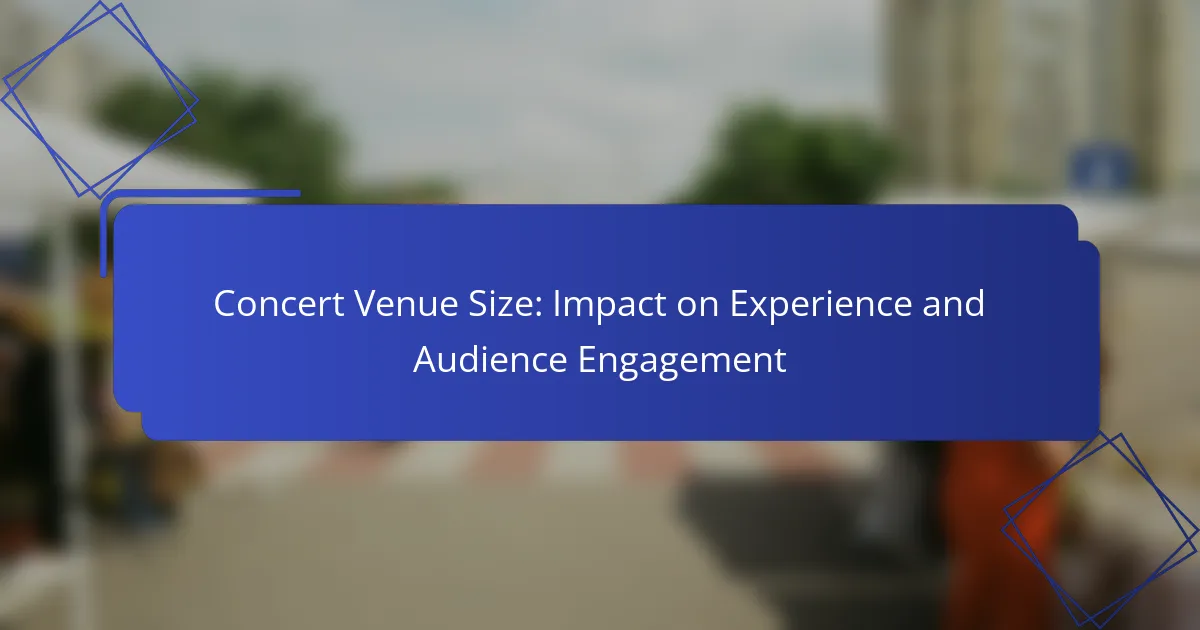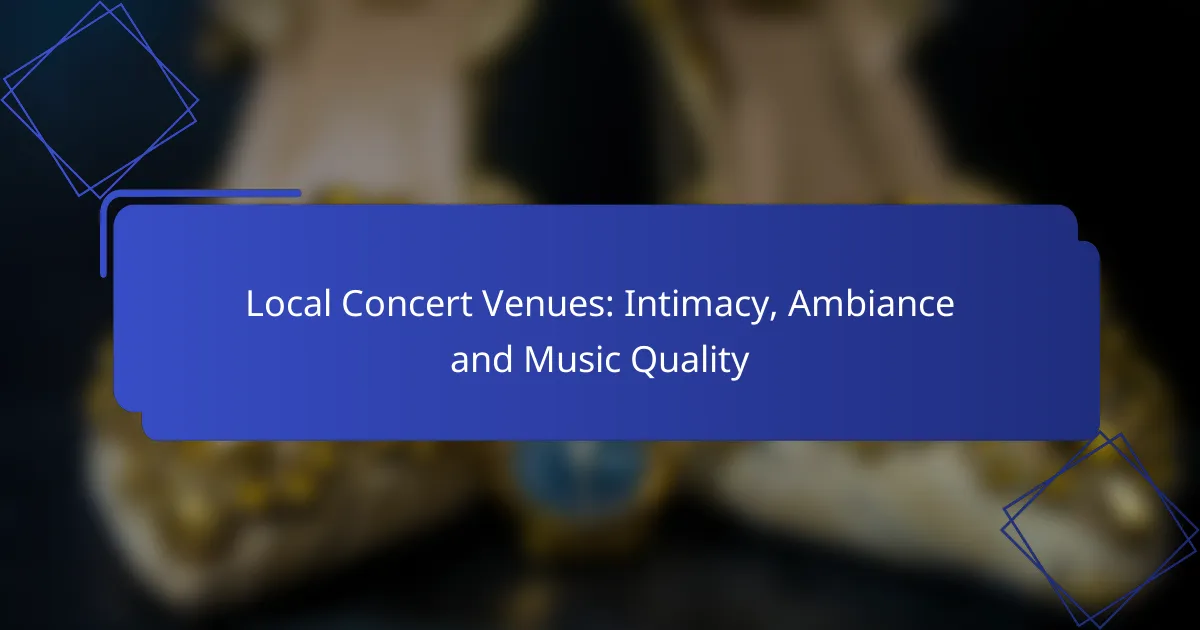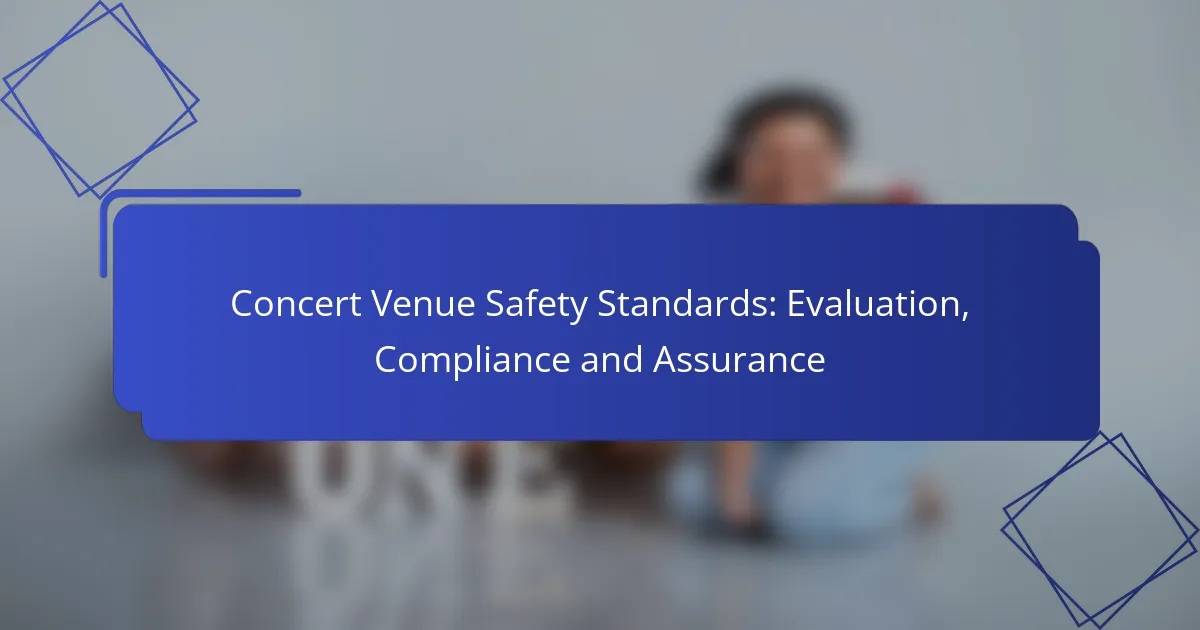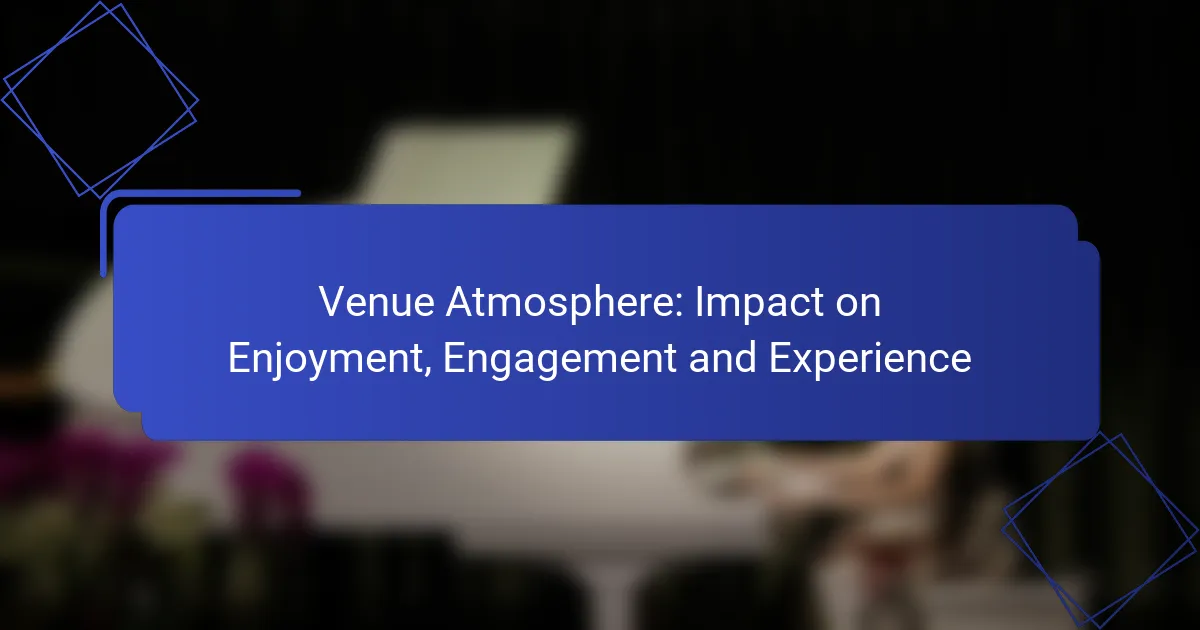The size of a concert venue plays a crucial role in shaping the audience’s experience and engagement. Smaller venues create an intimate atmosphere that fosters a close connection between performers and attendees, while larger venues generate a vibrant energy that can enhance the overall performance. Understanding the impact of venue size is essential for both artists and fans, as it influences everything from sound quality to ticket pricing.

How does concert venue size affect audience engagement?
The size of a concert venue significantly impacts audience engagement by influencing the atmosphere, sound quality, and overall experience. Smaller venues tend to foster a more intimate connection between the performers and the audience, while larger venues can create a dynamic energy that enhances the performance but may dilute personal interaction.
Intimacy in smaller venues
Smaller venues, typically accommodating a few hundred to a couple of thousand attendees, allow for closer proximity to the performers. This intimacy can lead to a more personal experience, where audience members feel more connected to the music and the artist.
In these settings, artists often engage directly with fans, sharing stories or encouraging sing-alongs, which enhances the overall enjoyment. The acoustics in smaller spaces can also be more favorable, allowing for a clearer sound that resonates well with the audience.
Energy dynamics in larger venues
Larger venues, which can host thousands of fans, generate a different kind of energy that can be electrifying. The sheer size of the crowd can amplify the excitement, creating a powerful atmosphere that enhances the performance.
However, the distance between the audience and the stage may lessen personal engagement. Artists may rely on visual effects and sound engineering to reach the audience, which can sometimes overshadow the personal connection that smaller venues provide.
Audience interaction opportunities
In smaller venues, opportunities for audience interaction are abundant. Fans can ask questions, request songs, or even meet artists after the show, creating memorable experiences that larger venues often cannot replicate.
Conversely, larger venues may offer limited interaction due to the scale of the event. However, they often incorporate technology, such as social media engagement or live screens, to enhance audience participation. Understanding these differences can help fans choose the right venue for their desired concert experience.

What are the ideal venue sizes for different genres?
The ideal venue size varies significantly by music genre, impacting both the audience experience and engagement levels. Smaller venues often suit intimate performances, while larger arenas cater to high-energy shows, each offering unique atmospheres and interactions.
Small venues for acoustic performances
Small venues, typically accommodating up to a few hundred attendees, are perfect for acoustic performances. These intimate settings allow for close interaction between the artist and the audience, enhancing the emotional connection of the music.
Examples of small venues include coffee shops, small theaters, and local bars. When planning an acoustic show, consider the venue’s acoustics and layout to ensure optimal sound quality and audience engagement.
Medium venues for pop concerts
Medium venues, ranging from several hundred to a couple of thousand seats, are ideal for pop concerts. They strike a balance between intimacy and energy, allowing for a more dynamic experience while still maintaining a connection with the audience.
These venues often feature better sound systems and lighting setups, which enhance the overall performance. When selecting a medium venue, consider factors like sightlines and accessibility to ensure a comfortable experience for all attendees.
Large arenas for rock shows
Large arenas, accommodating thousands of fans, are designed for rock shows that demand high energy and spectacle. These venues provide the space needed for elaborate stage setups and large crowds, creating an electrifying atmosphere.
When organizing a rock concert in a large arena, focus on sound quality, visual effects, and crowd management. It’s crucial to ensure that every attendee feels engaged, even from the back rows, by investing in high-quality audio equipment and visual displays.

How can venue size influence ticket pricing?
Venue size significantly impacts ticket pricing due to the varying costs associated with different capacities and the audience experience. Smaller venues often have lower overhead costs, allowing for more flexible pricing, while larger arenas may implement dynamic pricing strategies to maximize revenue based on demand.
Pricing strategies for small venues
Small venues typically adopt straightforward pricing strategies that cater to their intimate setting. Ticket prices may range from low to moderate, often between $10 to $50, depending on the artist’s popularity and the local market. These venues can offer tiered pricing or discounts for early purchases to encourage attendance.
Additionally, small venues might provide bundled packages, such as including merchandise or drinks with ticket sales, enhancing perceived value without significantly raising prices. This approach fosters a loyal audience base and encourages repeat visits.
Dynamic pricing in large arenas
Large arenas frequently utilize dynamic pricing models to adjust ticket prices based on real-time demand and availability. Prices can fluctuate significantly, sometimes ranging from $30 to several hundred dollars for popular events. This strategy allows venues to capitalize on high demand, especially for major artists or events.
While dynamic pricing can maximize revenue, it may alienate some fans who feel priced out. To mitigate this, large venues often offer a range of ticket options, from premium seats to more affordable general admission, ensuring accessibility while still optimizing profits.
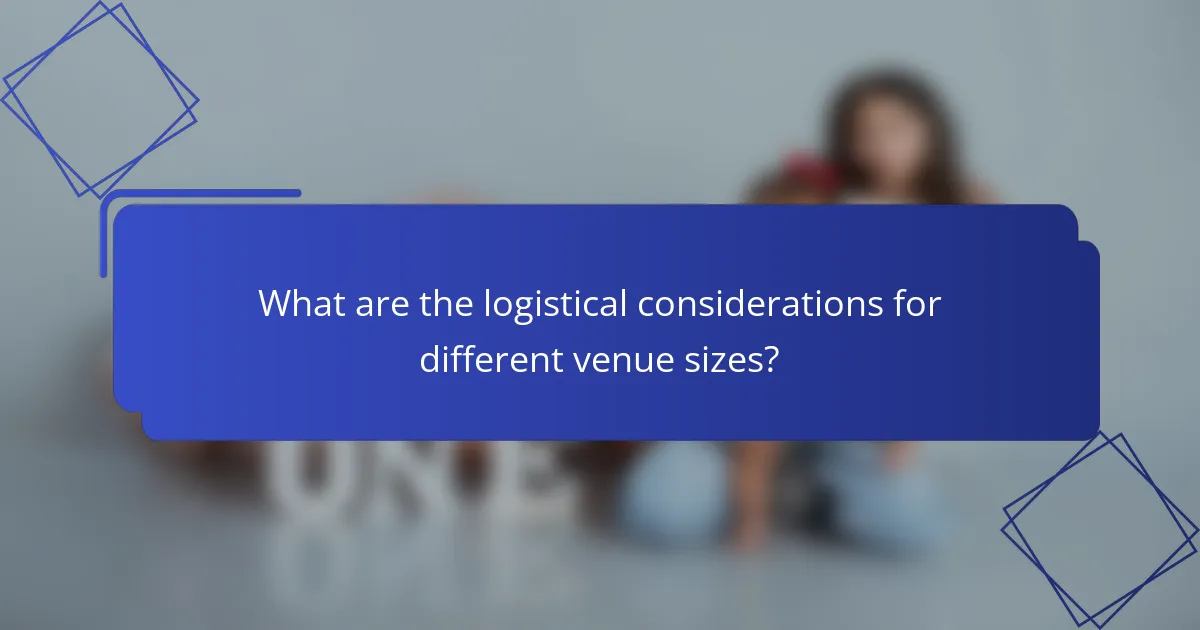
What are the logistical considerations for different venue sizes?
Logistical considerations vary significantly between small, medium, and large concert venues, impacting setup, sound quality, and accessibility. Understanding these factors helps ensure a smooth event experience for both organizers and attendees.
Setup and teardown times
Setup and teardown times can differ greatly depending on the venue size. Smaller venues may require just a few hours for both processes, while larger venues could take a full day or more due to the complexity of equipment and staging.
For efficient management, create a detailed timeline that accounts for each phase, including sound checks and equipment testing. Always allow for buffer time to handle unexpected delays, especially in larger venues where coordination is key.
Sound system requirements
Sound system requirements escalate with venue size. Smaller venues might only need basic PA systems, while larger venues require advanced sound reinforcement systems to ensure clear audio across the entire space.
Consider factors like audience size and venue acoustics when selecting equipment. For example, a medium venue may benefit from a line array system to distribute sound evenly, while larger venues often need multiple speaker clusters to cover extensive areas effectively.
Accessibility features
Accessibility features must be tailored to the venue size to accommodate all attendees. Smaller venues should ensure basic accessibility, such as wheelchair ramps and designated seating, while larger venues need comprehensive solutions, including accessible restrooms and clear signage.
It’s essential to comply with local regulations, such as the Americans with Disabilities Act (ADA) in the U.S., which outlines specific requirements for public venues. Regularly review and update accessibility plans to enhance the experience for all concertgoers, regardless of venue size.
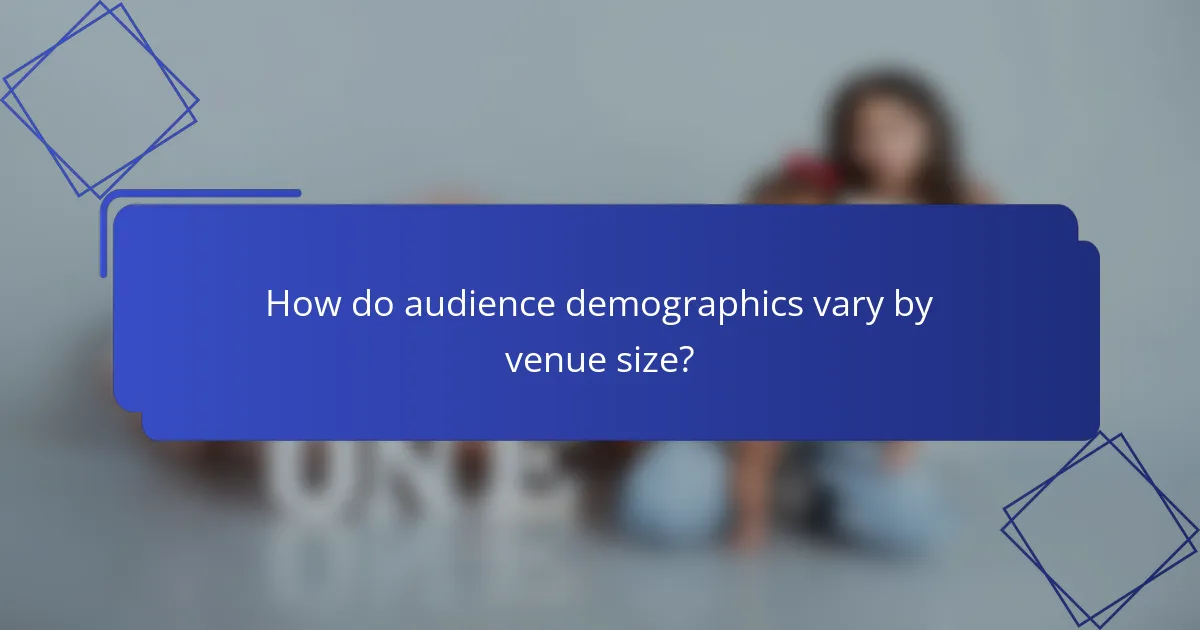
How do audience demographics vary by venue size?
Audience demographics can significantly differ based on the size of the concert venue. Smaller, intimate settings often attract a more diverse age range, while larger venues tend to draw in a younger crowd, often including tourists and casual attendees.
Age groups in intimate settings
Intimate concert venues, typically seating fewer than 500 people, often appeal to older audiences who appreciate the personal connection with performers. These venues foster an atmosphere conducive to engagement, allowing for direct interaction and a shared experience.
In these settings, attendees may range from young adults in their twenties to older music enthusiasts in their sixties or seventies. This diversity can lead to a richer, more varied audience experience, as different generations share their musical tastes and memories.
Tourist attendance in large venues
Large concert venues, which can accommodate thousands, frequently attract tourists who are looking for major events or popular artists. These venues often host well-known acts that appeal to a broad audience, making them a prime destination for visitors.
Tourists at large venues may skew younger, typically in their teens to thirties, as they seek out high-energy performances and the excitement of large crowds. This demographic shift can influence the overall atmosphere, creating a vibrant, dynamic experience that differs from smaller shows.

What are the emerging trends in concert venue design?
Emerging trends in concert venue design focus on enhancing audience engagement and experience through innovative layouts and advanced technology. These trends prioritize flexibility and interactivity, allowing venues to adapt to various performance types and audience preferences.
Flexible space configurations
Flexible space configurations enable concert venues to accommodate different types of events, from intimate performances to large-scale concerts. This adaptability often involves movable seating, adjustable stages, and modular design elements that can be reconfigured based on the event’s needs.
For instance, some venues utilize retractable seating systems that can transform a space from a seated concert to a standing room setup, maximizing capacity and enhancing the atmosphere. This flexibility can lead to increased ticket sales and a more tailored experience for attendees.
Technology integration for enhanced experiences
Technology integration in concert venues enhances audience experiences through features like advanced sound systems, interactive displays, and mobile apps. These technologies can provide real-time information, such as setlists and artist bios, directly to attendees’ devices, creating a more immersive environment.
Moreover, venues are increasingly incorporating augmented reality (AR) and virtual reality (VR) elements to engage audiences before and during events. For example, AR apps can offer backstage tours or interactive elements that allow fans to connect with performers in new ways, enriching the overall concert experience.
